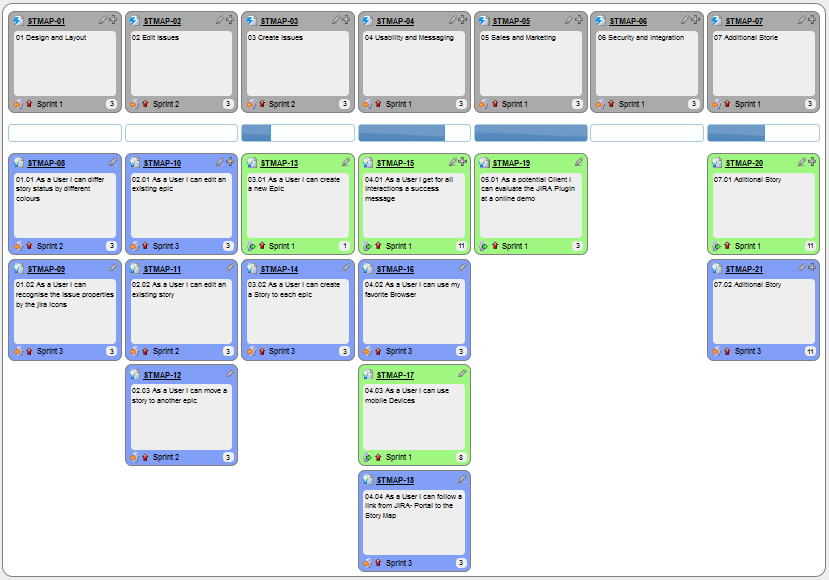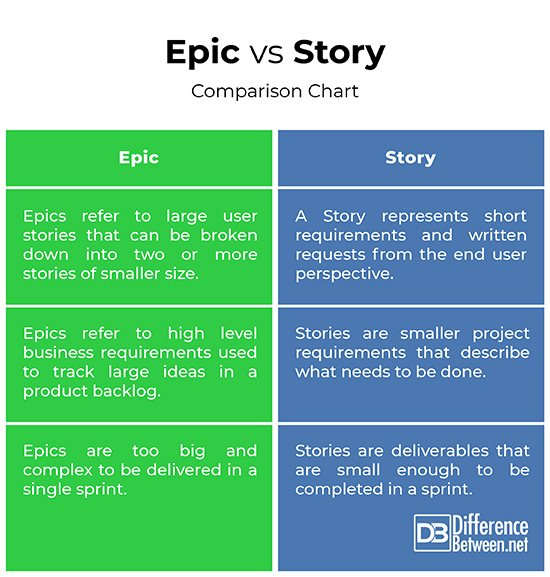Difference Between Jira Epic and Story
Atlassian Jira is arguably one of the best bug/issue tracking and task management tools out there, which not only supports Agile based methodologies but also supports two of the most common Agile based practices, Scrum and Kanban. Although, it was initially designed for tracking bugs, Jira has evolved over the years into a powerful, feature-rich project management platform for businesses of all sizes. But, before you start working with Jira, you need to familiarize yourselves with some key concepts and terminologies that make up the whole Jira ecosystem. Two such commonly used terminologies are Epics and Stories.

What is User Story?
Stories, also called user stories, refer to short requirements and written requests from the end user perspective. Stories are software requirements or functionalities that need to be implemented and which will provide value to either the end user or the purchaser of a system or software. User stories are typically written in a non-technical fashion and describe what needs to be done and how to communicate the requirements to the development team. A story in Jira is represented as an issue of type Story. It tells a story about a customer or user employing the product. A story has a name, a brief narrative, and acceptance criteria, conditions that must be met for the story to be completed.
A story needs to be in a granular format so that it best defines the end goal, providing a bigger picture of a project, eventually allowing the development team to focus on the tasks that need to be done within a specified frame. A user story is composed of three main aspects: a written description of the product requirements or functionality, conversations that flesh out the details of even the smallest of requirements of the user story, and documents that can verify when a story is complete. For a developer, a user story helps understand the execution level requirements, the details, acceptance criteria, and everything related to the story.

What is Epic?
User stories can be coarse-grained or detailed. Epics are such coarse-grained user stories, or you can call them “bigger stories” or “features” because they are too large to be of much use. Epics in Jira refer to large user stories which can be broken down to two or more stories of smaller size, or more manageable user stories. Epics are large chunks of work that typically describe a group of issues related to one or multiple projects. They are basically a chunk of work with a common objective and they could be anything, like a feature a customer requested, a technical issue that needs to be addressed, or just anything that would typically require more than one sprint.
Epics can be, but not essentially required to be, done in a single sprint; they may take several sprints before they are being delivered, and in the same order the user stories they contain are prioritized. So, it’s a great grouping tool that can you can use in your Jira projects to get a clear sense of the whole project – where you are at, when needs to be done, and who is tasked to do it. It is a group of related stories that will be split into their component stories before it becomes a part of a sprint.
Difference between Jira Epic and Story
Definition
– Stories, also called user stories, are software requirements or functionalities that need to be implemented and which will provide value to either the end user or the purchaser of a system or software. Epics, on the other hand, are larger user stories that can be broken down into smaller, manageable stories before the start of a sprint. Epics are large chunks of work that typically describe a group of issues related to one or multiple projects.
Purpose
– Both Epics and User Stories are tightly linked to each other, and both are created by either the product owner or the business analyst who’s assisting the product owner. Stories are smaller project requirements that describe what needs to be done and how to communicate the requirements to the development team. Epics, on the other hand, refer to high level business requirements that are too big and complex to be delivered in a single sprint. They are a group of related stories that will be split into their component stories during the initial product roadmapping.
Hierarchy
– User stories represent individual features or functionalities that need to be implemented as instructed by the product owner. These are deliverables that are small enough to be completed in a sprint and are created throughout the product development lifecycle. But, when stories or issues get complex and big enough to not fit into a single sprint, they become Epics. So, Epics are bigger stories that are just too big to be delivered in a sprint, so they are broken down into smaller, easy to manage stories. Epics are a grouping tool that group related issues together so you can better organize your work.
Epic vs. Story: Comparison Chart

Summary
While both Epics and User Stories are tightly linked to each other and both serve to manage tasks, they serve a different purpose. Epics sit at the upper level of the hierarchy when it comes to product development which describes one big portion of the product functionality, so big that it cannot be completed in one sprint and should be broken down into small chunks of works, called “user stories”. Stories are basically simple product requirements or features to be implemented as instructed by the product owner. So, the main difference between the two lies in the scale of view.
- Difference Between Caucus and Primary - June 18, 2024
- Difference Between PPO and POS - May 30, 2024
- Difference Between RFID and NFC - May 28, 2024
Search DifferenceBetween.net :
Leave a Response
References :
[0]Li, Patrick. Jira Software Essentials: Plan, Track, and Release Great Applications with Jira Software, 2nd Edition. Birmingham, United Kingdom: Packt Publishing, 2018. Print
[1]Cohn, Mike. User Stories Applied: For Agile Software Development. Massachusetts, United States: Addison-Wesley Professional, 2004. Print
[2]Pichler, Roman. Agile Product Management with Scrum: Creating Products that Customers Love. New Delhi, India: Pearson Education India, 2010. Print
[3]Li, Patrick. JIRA Essentials - Third Edition. Birmingham, United Kingdom: Packt Publishing, 2015. Print
[4]Image credit: https://commons.wikimedia.org/wiki/File:User_Story_Map_in_Action.png
[5]Image credit: https://go.isostech.com/hubfs/Using%20Jira%20Epics.jpg
